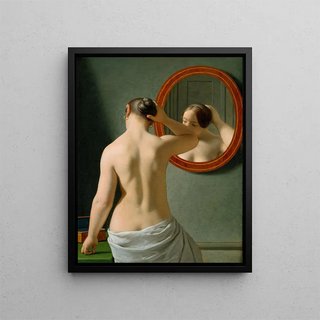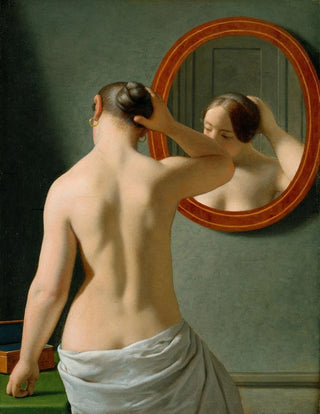Art print | A nude woman styling her hair in front of a mirror - Christoffer Wilhelm Eckersberg


View from behind

Frame (optional)
The artwork "A nude woman styling her hair in front of a mirror" by Christoffer Wilhelm Eckersberg is a true ode to feminine beauty and sensuality, capturing a moment of intimacy and reflection. Painted in the 19th century, this canvas stands out for its bold approach to the female nude, while incorporating a psychological depth that invites viewers to question the very nature of beauty. The mirror, a symbol of reflection and self-assessment, becomes a central element here, revealing not only the outer image of the woman but also her inner world. This piece thus becomes a mirror of the society of its time, while remaining timeless in its message.
Style and uniqueness of the work
Eckersberg's style is characterized by remarkable technical mastery and a keen sense of composition. In "A nude woman styling her hair in front of a mirror," light plays a vital role, enveloping the female figure in an almost ethereal softness. The delicate nuances of the skin, contrasting with subtle shadows, testify to an impressionist sensitivity that foreshadows future artistic movements. The artist also uses elements of nature, such as reflections and textures, to accentuate the sensuality of the scene. The woman's posture, both vulnerable and confident, evokes a fascinating duality, where intimacy blends with power. The canvas is thus a perfect example of an aesthetic that celebrates the human body while exploring deeper themes such as identity and self-perception.
The artist and his influence
Christoffer Wilhelm Eckersberg, often regarded as the father of Danish realism, played a crucial role in the evolution of art in the 19th century. Trained at the Royal Danish Academy of Fine Arts in Copenhagen, he was influenced by the great European masters, while developing a style unique to himself. His ability to capture light and texture made him a pioneer in landscape and portrait art. Eckersberg was also a mentor to many Danish artists, contributing to the emergence of a national artistic school. His impact goes beyond his works, as he knew how to

Matte finish

View from behind

Frame (optional)
The artwork "A nude woman styling her hair in front of a mirror" by Christoffer Wilhelm Eckersberg is a true ode to feminine beauty and sensuality, capturing a moment of intimacy and reflection. Painted in the 19th century, this canvas stands out for its bold approach to the female nude, while incorporating a psychological depth that invites viewers to question the very nature of beauty. The mirror, a symbol of reflection and self-assessment, becomes a central element here, revealing not only the outer image of the woman but also her inner world. This piece thus becomes a mirror of the society of its time, while remaining timeless in its message.
Style and uniqueness of the work
Eckersberg's style is characterized by remarkable technical mastery and a keen sense of composition. In "A nude woman styling her hair in front of a mirror," light plays a vital role, enveloping the female figure in an almost ethereal softness. The delicate nuances of the skin, contrasting with subtle shadows, testify to an impressionist sensitivity that foreshadows future artistic movements. The artist also uses elements of nature, such as reflections and textures, to accentuate the sensuality of the scene. The woman's posture, both vulnerable and confident, evokes a fascinating duality, where intimacy blends with power. The canvas is thus a perfect example of an aesthetic that celebrates the human body while exploring deeper themes such as identity and self-perception.
The artist and his influence
Christoffer Wilhelm Eckersberg, often regarded as the father of Danish realism, played a crucial role in the evolution of art in the 19th century. Trained at the Royal Danish Academy of Fine Arts in Copenhagen, he was influenced by the great European masters, while developing a style unique to himself. His ability to capture light and texture made him a pioneer in landscape and portrait art. Eckersberg was also a mentor to many Danish artists, contributing to the emergence of a national artistic school. His impact goes beyond his works, as he knew how to






